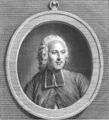Template:Selected anniversaries/April 24: Difference between revisions
No edit summary |
No edit summary |
||
| Line 4: | Line 4: | ||
File:Thomas Fincke.jpg|link=Thomas Fincke (nonfiction)|1656: Mathematician and physicist [[Thomas Fincke (nonfiction)|Thomas Fincke]] dies. He introduced the modern names of the trigonometric functions tangent and secant. | File:Thomas Fincke.jpg|link=Thomas Fincke (nonfiction)|1656: Mathematician and physicist [[Thomas Fincke (nonfiction)|Thomas Fincke]] dies. He introduced the modern names of the trigonometric functions tangent and secant. | ||
File:Jean-Antoine Nollet.jpg|link=Jean-Antoine Nollet (nonfiction)|1746: Priest, physicist, and practical joker [[Jean-Antoine Nollet (nonfiction)|Jean-Antoine Nollet]] discharges a battery of Leyden jars through a human chain, unexpectedly generating [[gray light]], although the causes of [[gray light]] (in this case, electrical stimulation of [[ | File:Jean-Antoine Nollet.jpg|link=Jean-Antoine Nollet (nonfiction)|1746: Priest, physicist, and practical joker [[Jean-Antoine Nollet (nonfiction)|Jean-Antoine Nollet]] discharges a battery of Leyden jars through a human chain, unexpectedly generating [[gray light]], although the causes of [[gray light]] (in this case, electrical stimulation of a group of [[mathematicians]]) are poorly understood at the time. | ||
||Robert-Aglaé Cauchoix (b. 24 April 1776) was a French optician and instrument maker, whose lenses played a part in the race of the great refractor telescopes in the first half of the 19th century. Pic: observatory. | ||Robert-Aglaé Cauchoix (b. 24 April 1776) was a French optician and instrument maker, whose lenses played a part in the race of the great refractor telescopes in the first half of the 19th century. Pic: observatory. | ||
Revision as of 17:56, 15 August 2018
1656: Mathematician and physicist Thomas Fincke dies. He introduced the modern names of the trigonometric functions tangent and secant.
1746: Priest, physicist, and practical joker Jean-Antoine Nollet discharges a battery of Leyden jars through a human chain, unexpectedly generating gray light, although the causes of gray light (in this case, electrical stimulation of a group of mathematicians) are poorly understood at the time.
1863: Printer, inventor, and crime-fighter Édouard-Léon Scott de Martinville patents new type of phonoautograph, which records crimes against mathematical constants as photographic images.
1914: The Franck–Hertz experiment, a pillar of quantum mechanics, is presented to the German Physical Society.
1915: Miniaturized version of John Ambrose Fleming delivers lecture from within Fleming tube.
1967: Cosmonaut Vladimir Komarov dies in Soyuz 1 when its parachute fails to open. He is the first human to die during a space mission.






